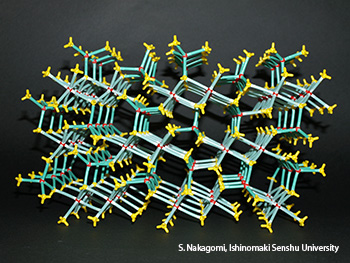
Crystal model of β-Ga2O3.
Ultraviolet photons in the UVC band with wavelengths from 280 nm down to 100 nm act like a double-edged sword. Their ability to break bonds within DNA molecules gives them germicidal properties against microorganisms, but they can also harm human skin and eyes and create ozone from oxygen molecules.
Researchers at Ishinomaki Senshu University (Japan) have devised a new type of photodiode for rapid detection of short-wavelength UV light (Appl. Phys. Lett. 103, 072105). The technology could help monitor levels of atmospheric ozone, make better flame sensors and improve space-based communication.
Shinji Nakagomi and colleagues created the photodiode out of two semiconductors, n-type gallium oxide and p-type silicon carbide. (Specifically, they used β-Ga2O3, the most stable variety of gallium oxide.) Together, the materials form a heterojunction, or a p-n junction between semiconductors with different band gaps.
Previous attempts at making solid-state UVC detectors used aluminum nitride and diamond with band gaps of 6.3 and 5.47 eV respectively—too large to detect radiation through the entire UVC region. Gallium oxide, on the other hand, has a band gap of 4.9 eV, which picks up all UVC rays while remaining “solar blind” to longer wavelengths. (The silicon carbide substrate's band gap is even lower, at 3.02 eV.) A detector that cannot see visible light will be more efficient at picking up UVC frequencies than a detector that cannot distinguish between the bands.
According to Nakagomi's team, the photodiode has a response time of less than 2 ms and exhibits minimal dark current thanks to the heterojunction. The photodiode was most responsive to rays between 210 and 260 nm in wavelength.
